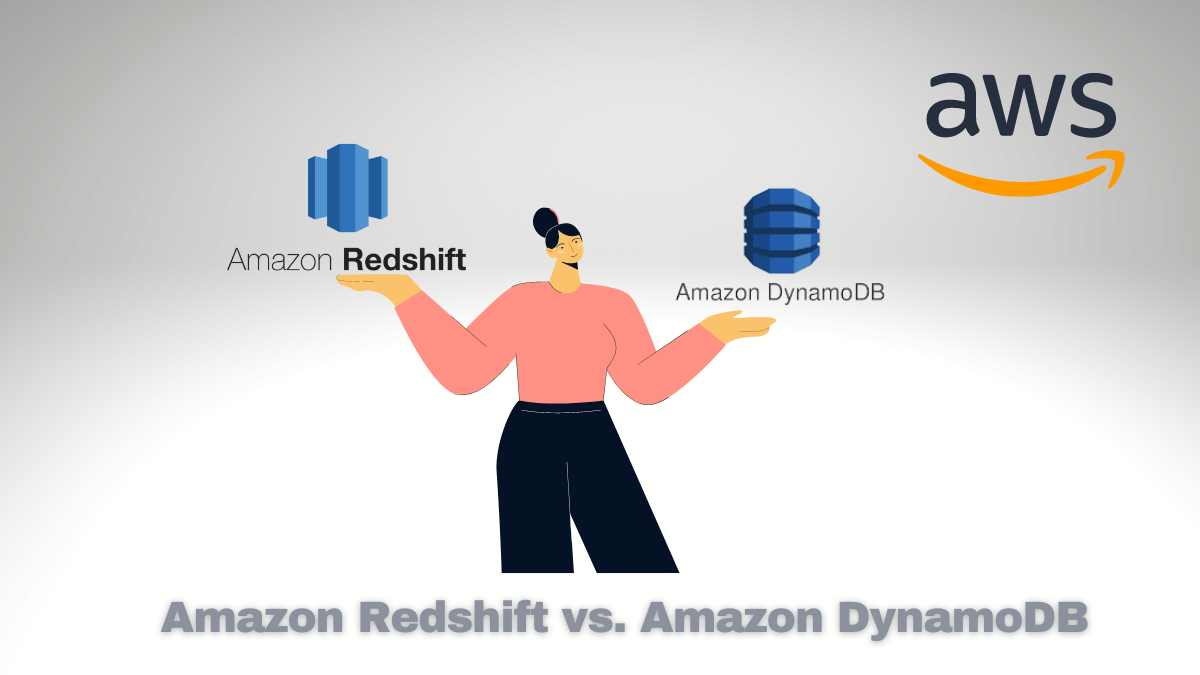Amazon Redshift vs. Amazon DynamoDB

Amazon Redshift vs. Amazon DynamoDB are two of the most popular database services offered by Amazon Web Services (AWS). Both services have their unique strengths and weaknesses, and the best choice for you will depend on your specific needs.
In this blog post, we will compare Redshift and DynamoDB in detail and provide tips on choosing the exemplary service for your business.
What is Amazon Redshift?
Amazon Redshift is a fully managed, petabyte-scale data warehouse service in the cloud. It offers high performance, scalability, and security, making it an excellent choice for businesses that need to store and analyze large amounts of data.
Redshift uses columnar storage, which is more efficient for analytical workloads than traditional row-based storage. It also supports ACID transactions, which is important for businesses that need to maintain the integrity of their data.
Redshift is a good choice for businesses that need to:
- Store and analyze large amounts of data
- Perform complex analytical queries
- Maintain the integrity of their data
What is Amazon DynamoDB?
Amazon DynamoDB is a fully managed, scalable NoSQL database service with high availability and durability. It is a good choice for businesses that need to store and access large amounts of data quickly and easily.
DynamoDB is a good choice for businesses that need to:
- Store and access large amounts of data
- Scale their database quickly and easily
- Access data quickly and easily
Learn More
AWS is the leading cloud computing platform, and learning AWS is essential for anyone who wants to succeed in the cloud computing industry.
Our AWS Learning Kit is the perfect way to get started with AWS. It includes comprehensive tutorials and practice exams designed to help you learn AWS quickly and easily.
Here are just a few of the benefits of learning AWS:
- High demand: There is a high demand for AWS skills, and AWS professionals are in high demand.
- High salaries: AWS professionals earn high salaries, which are expected to grow in the coming years.
- Job security: The cloud computing industry is growing rapidly, and there is a high demand for AWS professionals. AWS professionals are less likely to be laid off than professionals in other industries.
Our AWS Learning Kit is the perfect place to start if you want to learn AWS and succeed in the cloud computing industry.
Download our AWS Learning Kit today and start your journey to a successful career in cloud computing!
Comparison Amazon Redshift vs. Amazon DynamoDB
| Factor | Amazon Redshift | Amazon DynamoDB |
|---|---|---|
| Data Storage | Columnar | Key-value |
| Data Model | Relational | NoSQL |
| Scalability | Horizontal | Vertical |
| Performance | High for analytical workloads | High for read and write workloads |
| Cost | Pay-as-you-go | Pay-as-you-go |
| Availability | Global | Global |
| Durability | 99.999% | 99.99% |
Which service is right for you?
The best way to choose between Redshift and DynamoDB is to consider your specific needs. If you need to store and analyze large amounts of data, Redshift is a good choice. If you need to store and access large amounts of data quickly and easily, DynamoDB is a good choice.
Here are some questions to ask yourself to help you choose the right service:
- How much data do I need to store?
- What type of data do I need to store?
- How often will I need to access my data?
- What type of queries will I be running?
- How much performance do I need?
- What is my budget?
Once you have answered these questions, you should know which service is right for you.
Real-world examples
Here are some real-world examples of how businesses are using Redshift and DynamoDB:
- Netflix uses Redshift to store and analyze users’ viewing habits. This data helps Netflix to recommend movies and TV shows to its users and to improve its overall user experience.
- Lyft uses DynamoDB to store and access data about its rides. This data helps Lyft to improve its ride-matching algorithm and to provide a better experience for its riders and drivers.
- Medium uses DynamoDB to store and access data about its articles. This data helps Medium personalize its users’ recommendations and improve its overall user experience.
Here are some additional things to consider when choosing between Redshift and DynamoDB:
- Data storage. Redshift uses columnar storage, which is more efficient for analytical workloads than traditional row-based storage. DynamoDB, on the other hand, uses key-value storage, which is more efficient for read-and-write workloads.
- Data model. Redshift is a relational database storing data in tables and rows. DynamoDB is a NoSQL database, meaning that data can be stored in various formats, including key-value pairs, documents, and graphs.
- Scalability. Redshift is horizontally scalable, which means adding more nodes to your cluster to increase capacity. DynamoDB is also horizontally scalable, but it can also be scaled vertically by increasing the size of your nodes.
- Performance. Redshift is designed for analytical workloads, offering high performance for queries that scan large amounts of data. DynamoDB is designed for read-and-write workloads, offering high performance for queries that read or write small amounts of data.
- Cost. Redshift and DynamoDB offer pay-as-you-go pricing, but the cost of each service will vary depending on your usage.
- Availability. Redshift and DynamoDB are available in multiple regions worldwide so that you can choose a region close to your users.
- Durability. Redshift and DynamoDB are highly durable, with 99.999% and 99.99% availability, respectively.
Conclusion
Redshift and DynamoDB are two robust database services that can be used for various purposes. The best choice for you will depend on your specific needs. By considering your requirements and using the questions in this blog post, you can choose the exemplary service for your business.




Comments